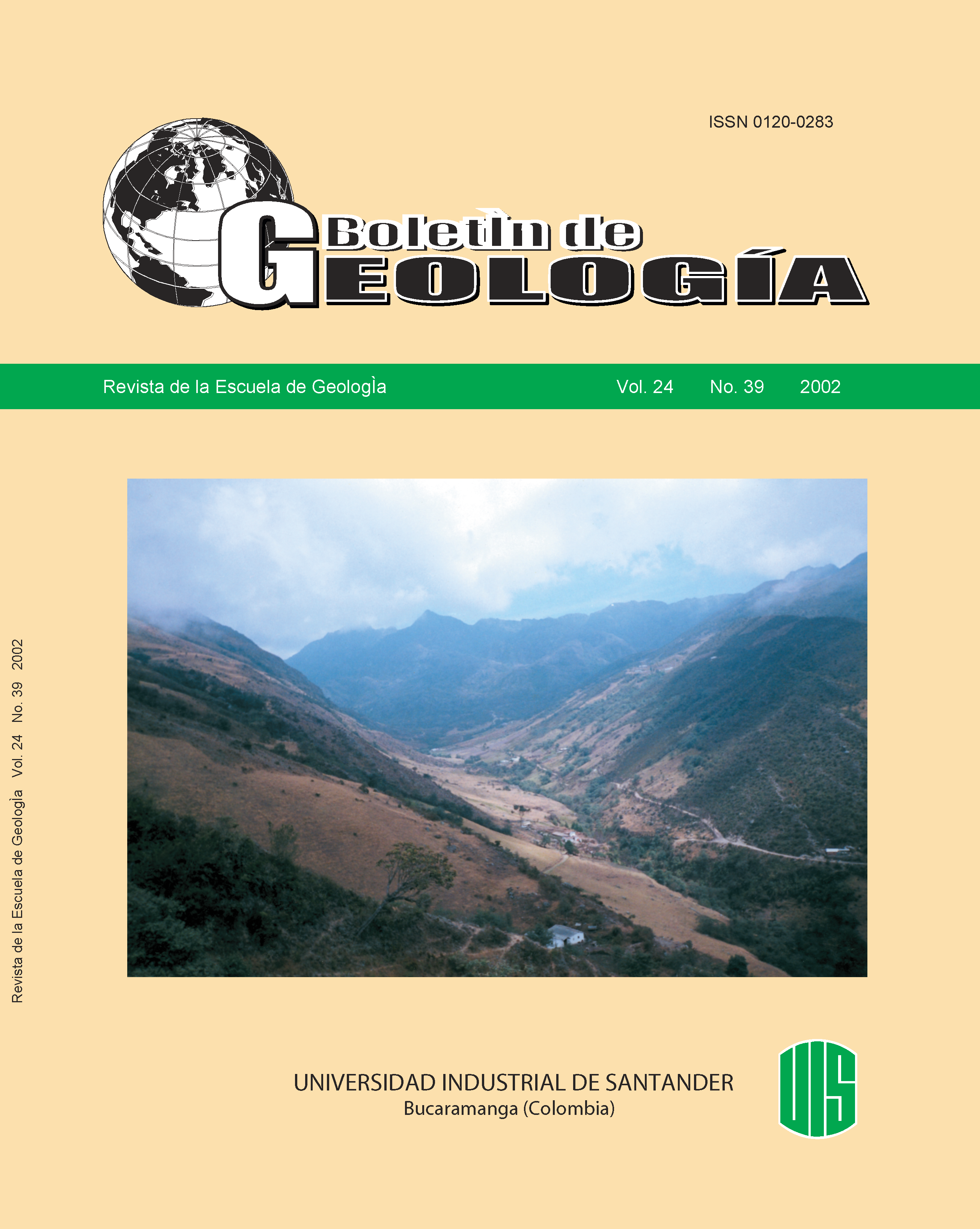Estudio del proceso de rehidratación de las rocas metamórficas de la Formación Silgará a partir del análisis composicional de la Clorita, región suroccidental del Macizo de Santander
Published 2002-06-04
Keywords
- Santander Massif,
- Silgará Formation,
- Chlorites,
- Rehydration
How to Cite
Abstract
Chlorites in metamorphic rocks of the Silgará Formation that crop out in the southwestern region of the Santander Massif (Chicamocha Canyon) registre formation temperatures between 180 and 355°C. The maximun temperatures of formation of this hydrated mineral phase (up to 355°C) correspond to the highergrade metamorphic zone (staurolite-distene), while in the biotite and garnet (upper part) zones, these temperatures vary in average between 180 and 270°C. These values of temperature suggest a rehydration of the greater depth rocks rather than those from higher structural levels of the metamorphic pile. This process appears to be explained in an extensive deformation context, which has generated a major amount of anysotropy planes in depth, by which hydrothermal fluids circulated. Besides, the generation of these channels should be related to the incompetent behavior of these lithologies in a great part of the exhumation history of the this Formation.
Downloads
References
Fyfe, W. (1973). Dehidration reaccions. Am. Assoc.Petrol. Geol., Vol. 57, pp. 190-197.
García, C., Ríos, C. (1999). Metamorfismo ymetalogenia asociada del Macizo de Santander,Cordillera Oriental (COLOMBIA). Informe final delproyecto de investigación 1102-05-083-95Colciencias - Universidad Industrial de Santander,Bucaramanga, p. 191
Goldsmith, R., Marvin, R., Mehnert, H. (1971).Radiometric ages in the Santander Massif, easternCordillera, Colombian Andes. U.S. Geological SurveyProfessional Paper, 750-D, pp. D41-D49
Hey, M. (1954). A new review of the chlorites.Mineralogical Magazine, Vol. 25, pp. 277-292
Kretz, R. (1983). Symbols for rock-forming minerals.American Mineralogist, Vol. 68, pp. 277-279
Lindsey, D. (1986). Heating, cooling, and uplift duringTertiary time, northern Sangre de Cristo Range,Colorado. Geol. Soc. of Am. Bull., Vol. 97, pp. 1133-1143.
Mantilla, L., Ordóñez, J., Cepeda, S., Ríos, C. (2001).Estudio de los paleofluidos en la Formación Silgaráy su relación con procesos de deformación. SectorAaratoca-Pescadero (SW del Macizo de Santander).Boletín de Geología UIS, Vol. 23, No. 38, pp. 69-75
Musumeci, G. (1992). Ductile wrench tectonics andexhumation of hercynian metamorphic basament inSardinia: Monte Grighini Complexe. GeodinamicaActa 5, pp. 119-133
Ríos, C. (1999). Chemical Compositions of theConstituent Minerals and P-T Conditions of the Low-grade Silgará Formation Metamorfic Rocks in theSantander Massif, Eastern Cordillera, ColombianAndes. MSc. Thesis, Shimane University, Matsue(Japan), p. 207.
Robinson, D. (1987). Transition from diagenesis tometamorphism in extensional and collisional settings.Geology, Vol. 15, pp. 866-869
Robinson, D. (1987). Transition from diagenesis tometamorphism in extensional and collisional settings.Geology, Vol. 15, pp. 866-869
Robinson, D. (1987). Transition from diagenesis tometamorphism in extensional and collisional settings.Geology, Vol. 15, pp. 866-869
Sanchez, A. (2001). La reacción de deshidrataciónde la muscovita en el gneiss de Torrox. Boletín de laSociedad Española de Mineralogía, Vol. 24-A, pp.141-142
Selverston, J. (1988). Evidence for East-West crustalextension in the eastern Alps. Implicacions for theunroofing history of the Tauern Window. Tectonics,Vol. 7, pp. 87-105
Walshe, J. (1986). A Six-Component Chlorite SolidSolution Model and the Conditions of ChloriteFormation in Hydrothermal and Geothermal Systems.Economic Geology, Vol. 81, pp.681-703.
Ward, D. et al. (1973). Geología de los CuadrángulosH-12, Bucaramanga y H-13, Pamplona, Departamentode Santander. U.S. Geological Survey e Ingeominas.Boletín Geológico, Vol. XXI, No 1-3
Zane, A., Weiss, Z. (1998). A procedure forclassification of rock-forming chlorites based onmicroprobe data. Rend. Fis. Accad. Lincei 9, Vol. 9,pp. 51-56
Zane, A., Sassi, R., Guidotti, Ch. (1998). New data onmetamorphic chlorite as petrogenetic indicator mineral,with special regard to greenschist-facies rocks. TheCanadian Mineralogist, Vol. 36, pp. 713-726.
